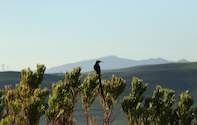
Bird watchers with a special interest in the small raptors are on standby at various points in the country, hoping to be the first to spot the arrival of the migrating kestrels that spend the summer months in South Africa.
The Endangered Wildlife Trust (EWT) Birds of Prey Working Group runs a Migrating Kestrel Project, and each year volunteers are encouraged to record sightings of three small raptors - the lesser kestrel, the Amur falcon and the red-footed falcon.
All three species are on the decline internationally, and the lesser kestrel is listed as globally vulnerable as its population has halved over the last few decades.
Formerly run by Hein Pienaar, the reins of the migrating kestrel project have been taken over by Anthony van Zyl. This year, the project is hoping to make a few changes in how the many volunteers around the country record kestrel sightings, and Anthony is encouraging more people to get involved in the project.
He is hoping to increase the number of known kestrel roosts around the country, especially in the lowveld. Anthony says, "Of particular interest is the Kruger National Park, in that it is probably the only place in South Africa where these birds may be roosting in indigenous trees. All the other roosts we know of, are in alien blue gums or pine trees.
There has a been a lot of debate over the years what these birds used to do in the time before we had all these aliens. Maybe the roosts in Kruger National Park hold a clue to the answer to this debate." Both Amur falcons and lesser kestrels have been reported from the lowveld.
Among the data volunteers can collect is the date of the first arrival of the kestrels, where the birds are seen (whether roosting or simply in flight), the number of birds at a roost, and the numbers of the different species seen at a single roost. The project has linked up with the Natural World website, and so all sightings and dates can be recorded on the database and then displayed on the website's maps.
Last year volunteers counted over 90,000 lesser kestrels in the 2005/6 summer at 44 different roosts. The first lesser kestrels of the season are usually recorded towards the end of October, with the Amur falcons arriving a few weeks later.
This year, the project plans to conduct a nationwide count in January, as opposed to counts in the beginning, middle and end of the season, although volunteers are encouraged to count more regularly if they wish to. Anthony will also be sending out PVC sheets to the volunteers who want to collect the pellets that the birds produce. These pellets will later be analysed to find out what the birds have been eating across the country.
Anthony has set up a website devoted to kestrels where more details on the migrating kestrel project can be found. Also on the site are numerous handy tips for telling the small raptors apart, as well as hints about how to count the birds when they form large flocks.
For more information log onto www.kestreling.com or contact Anthony van Zyl on 082 378 2226 or 021 781 0230
"Of particular interest is the Kruger National Park, in that it is probably the only place in South Africa where these birds may be roosting in indigenous trees."

